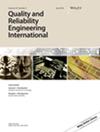具有两类相关阈值的竞争性故障过程的可靠性评估模型
IF 2.8
3区 工程技术
Q3 ENGINEERING, INDUSTRIAL
引用次数: 0
摘要
这两种依存竞争风险是由冲击引起的老化退化和碎裂导致的软失效和由相同冲击过程导致的弹簧断裂导致的硬失效。考虑到产品本身的复杂性和工作环境的不稳定性,本研究提出了一个广义的可靠性模型,适用于经历降解和随机冲击的依赖竞争失效过程(DCFP)的系统,该模型考虑了两种DCFP:(1)冲击过程可能影响软失效阈值;(2)降解过程可能影响硬失效阈值。在第(1)种情况下,我们考虑的是累计次数超过一定程度的冲击对软失效阈值变化的影响。在情况(2)中,我们不仅考虑了冲击过程对软失效阈值的影响,还考虑了总退化(包括持续退化和冲击引起的突然退化)对硬失效阈值的影响。该模型抓住了以下特点:系统所经历的冲击会影响退化过程,加速系统退化并导致软失效;系统的退化过程会影响冲击过程,使系统更容易受到外部冲击而失效。最后,以微型机电系统设备为例,通过敏感性分析说明了所提方法的有效性。本文章由计算机程序翻译,如有差异,请以英文原文为准。
Reliability assessment models for competing failure processes with two types of correlative thresholds
The two dependent competing risks are soft failure due to aging degradation and fragmentation caused by shocks and hard failure due to spring breakage caused by the same shock process. Considering the complexity of the product itself and the instability of the working environment, this study proposed a generalized reliability model for systems experiencing dependent competing failure processes (DCFPs) of degradation and random shocks, which considered two kinds of DCFP: (1) shock process could affect soft failure thresholds; (2) degradation process could affect hard failure thresholds. In case (1), we considered the effect that a cumulative number of shocks above a certain magnitude could have on the change in the soft failure threshold. In case (2), we considered not only the shock process's impact on the soft failure threshold but also the total degradation (including continuous degradation and sudden degradation caused by shock) on the hard failure threshold. The model captures the features that the shocks experienced by the system affect the degradation process, accelerating the system degradation and causing soft failures; the degradation process of the system affects the shock process, making the system more susceptible to failure from external shocks. Finally, an example using micro‐electro‐mechanical systems devices illustrates the effectiveness of the proposed approach with sensitivity analysis.
求助全文
通过发布文献求助,成功后即可免费获取论文全文。
去求助
来源期刊
CiteScore
4.90
自引率
21.70%
发文量
181
审稿时长
6 months
期刊介绍:
Quality and Reliability Engineering International is a journal devoted to practical engineering aspects of quality and reliability. A refereed technical journal published eight times per year, it covers the development and practical application of existing theoretical methods, research and industrial practices. Articles in the journal will be concerned with case studies, tutorial-type reviews and also with applications of new or well-known theory to the solution of actual quality and reliability problems in engineering.
Papers describing the use of mathematical and statistical tools to solve real life industrial problems are encouraged, provided that the emphasis is placed on practical applications and demonstrated case studies.
The scope of the journal is intended to include components, physics of failure, equipment and systems from the fields of electronic, electrical, mechanical and systems engineering. The areas of communications, aerospace, automotive, railways, shipboard equipment, control engineering and consumer products are all covered by the journal.
Quality and reliability of hardware as well as software are covered. Papers on software engineering and its impact on product quality and reliability are encouraged. The journal will also cover the management of quality and reliability in the engineering industry.
Special issues on a variety of key topics are published every year and contribute to the enhancement of Quality and Reliability Engineering International as a major reference in its field.

 求助内容:
求助内容: 应助结果提醒方式:
应助结果提醒方式:


